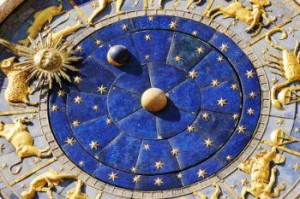The Outer Planets, last month we explored the romantic possibilities—and instant attractions— that can occur when angles meet planets in synastry. The angles act as a kind of magnetic antennae; we not only sense the world (and others) through them, but they act as a gateway for the evolution of our consciousness. No wonder they play a key role in drawing potential partners to us.
Angles and Inner Planets: Review
On the whole, the initial contact between angles and inner planets is a positive one. We might run into difficulties with the planet involved, but usually there is something about the urgency and energy of the angle that puts things right, at least for a time. That planet becomes important—elevated by its contact with the angle—and both people sense this. We tell ourselves, ‘we can work this out.’
 One of the reasons is that, well, we can work things out with an inner planet. Inner planets are tangible, accessible. Inner planets have to do with our real, everyday lives. In fact, the inner planets are the tools we use to negotiate the world. We feel and sense (Moon), we think (Mercury), we love and connect with what we love (Venus), we act (Mars), we grow (Jupiter) and we construct our world and make use of our experience (Saturn). We can make decisions about each of these planets and functions. We can go with our instincts or try to correct their expression through use of our conscious will.
One of the reasons is that, well, we can work things out with an inner planet. Inner planets are tangible, accessible. Inner planets have to do with our real, everyday lives. In fact, the inner planets are the tools we use to negotiate the world. We feel and sense (Moon), we think (Mercury), we love and connect with what we love (Venus), we act (Mars), we grow (Jupiter) and we construct our world and make use of our experience (Saturn). We can make decisions about each of these planets and functions. We can go with our instincts or try to correct their expression through use of our conscious will.
The Perversity of the Outer Planets
The difference between outer planets and inner planets is vast. Howard Sassportas described it well in his breakthrough book, The Gods of Change. They behave as if they have not a care in the world about us mere mortals. They are more willful, perverse and complex than any resident of Mount Olympus. It’s hard to pin them down to a simple function. We understand their motives—to change us, to shake us from our habits and complacency so that we become more aware, more alive. But their processes, and what seems at times to be an abject cruelty, baffle us.
Until we are awakened to ourselves, to our own potential, we don’t acknowledge them as part of us. They come out of the blue, from a place we do not recognize. This ‘shock of the new’ is especially potent when outer planets become active in our lives through our romantic partnerships. When they appear via ‘other’ we may fall in love deeply, intensely—but we must also brace ourselves for change and, possibly, for loss. It may be that we are required to relinquish a cherished part of ourselves.
The Shadow of the Descendent
In astrological terms, it’s easy to see why partnerships are designed to be both blissful and difficult. The Descendant, opposite the sign rising, represents ‘other’—our serious partnerships, yes, but also the Shadow, as defined by Carl Jung. It contains all that we cannot see or acknowledge in ourselves (this is also somewhat true of the IC as opposed to the midheaven). It is ripe for projection: we pin qualities on to others that they may not possess, qualities that are part of our own unacknowledged psyche.
In essence, partnership, in spiritual terms, is meant to reveal our darker and hidden sides to ourselves. This can include both gifts and so called ‘issues.’ The person with Leo rising and Aquarius on the Descendant may get involved with a series of relationships that end abruptly, causing Leo to question whether she is aware of her own need for detachment. The cautious Virgo rising may fall for a series of saints, drunks and others permanently unavailable, until she acknowledges her own Neptunian elements and embraces the artist within (Pisces Descendant).
On the whole, when we’re younger, we fall for the negative expression of the sign on the Descendant. (Of course, it all starts out positive, with the negative expression only revealing itself once we’ve gotten cozy.) Wisdom and experience gradually teach us, and once we embrace that shadow side of ourselves, better choices become not only possible, but probable.
The outer planets are at their most devastating when we refuse to see. If we reject growth and cling on to our lesser selves, the outer planets will make sure that the bond between us and our lesser selves is broken. And one of the quickest ways this happens is when the outer planet of one chart hits an angle in the other. It has its strongest impact when the planet touches the Descendant, but contact with the other angles can be just as intense and life-transforming.
”Death” by Outer Planets
All three of the outer planets represent a kind of death. We need to die to the lesser element of ourselves, and the outer planets are there to help us. They give us divine power on the one hand, and then abandon us with the other. We get a taste of holy bliss and then are ripped away. I always joke with my advanced synastry students that they get a choice of three ways of dying: you can get shot (Uranus), you can drown (Neptune) or you can get torn apart by bears (guess who?). Which one would you pick?
Actually, we don’t pick. The way we die to ourselves depends on which outer planet is prominent in the synastry. This can get complicated if a person doesn’t have much of that element in her chart. A double Scorpio, for example, might be very comfortable with a partner’s Pluto conjunct her Descendant. Yet this contact might devastate a person who is basically Neptunian, and unaware of the power plays that can arise in any partnership. A Uranian used to going her own way might be shaken to the core by the possessive intensity of her Plutonic relationship.
All inter-aspects are not equal, and a lot will depend on whether an individual accepts or rejects certain qualities in herself. This is one reason it’s necessary to assess the relative weighting of each of the outer planets in a natal chart before doing a synastry comparison.
When an outer planet hits an angle, all hell can break loose, and often does. It’s not an exaggeration to say that the relationship can open a person to a new way of experiencing life—but not without cost, and sacrifice. Each one of the outer planets demands a price for the wisdom offered. Whether we are wise enough to accept what is given, and jettison what is no longer working, or whether we cling on to the familiar at the expense of our own evolution, depends on whether or not we are willing to sacrifice our naivete and accept change in the name of our own wholeness. The gods of change may initially seem like gods of disruption, but in reality they are harbingers of the evolution of our awareness.
A new entry for my monthly column on Sasstrology.com, Synastry Studies, is up now. We’re exploring outer planets to angles and the purpose of relationship altogether.
Coming Up: A New Post on Astrology and the Archetype of Seasons, tomorrow!

Dear Dawn,
I´ve a question about outer planets to angles.
Natally A´s IC is conjunct pluto in scorpio square moon in leo which conjuncts the asc.
B is about the same age, so B´s pluto also hits A´s IC
and squares A´s moon.
Pluto is also B´s moon ruler (scorpio moon, first house, with libra rising).
B´s vertex is conjunct ( 5°) A´s MC. So I feel that B´s vertex
axis runs on A´s MC/IC axis.
What significance would B´s pluto placement to A´s chart have since its generational, all the guys around her age have their pluto on her IC?